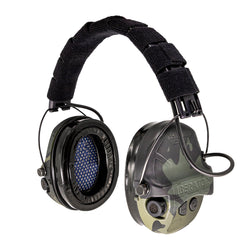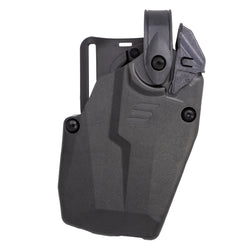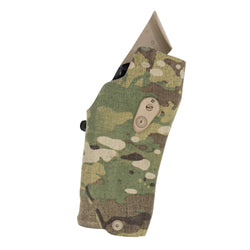Much has been made of the American maritime services’ “Pacific Pivot,” in which the Navy and Marine Corps have shifted their focus to the Indo-Pacific region. If that term is unfamiliar, “Indo-Pacific” refers to the Eastern Indian and Southwest Pacific Oceans, specifically where those oceans meet around Indonesia and Australia. The reason for that pivot is obvious if you know your geography: Communist China.
Despite the 3rd Marine Division’s Okinawa home, the Marine Corps has generally looked toward Europe and the Middle East since the United States left Vietnam in 1973. The Corps began resembling the Army as far back as Korea, due to the nature of that war and subsequent conflicts in Vietnam, Kuwait, Iraq, and Afghanistan. After the 1950 Inchon landing, there wasn’t much call for the amphibious operations that honed the Marines into the world’s foremost practitioners of that precise and demanding art during World War II.

But things are changing. The Marines have shed their large armored formations for a more agile program suited to a maritime environment. The Corps’ leadership is wisely not trying to reinvent the wheel in the process, because the Marine Corps faced a similar situation a century ago. And it turns out that what was old is suddenly new again.
A Rising Challenge in the Pacific
Winning the Spanish American War in 1898 suddenly gave the United States a stake in the Western Pacific. Spain ceded Guam and the Philippines, and economic interests in China made them valuable outposts. The Army maintained a significant presence in the Philippines because of the native insurrection, but defending the new possessions fell primarily to the Navy.
Naval planners quickly recognized their most likely adversary. Imperial Japan was a rising power in the Far East. Japan defeated China in 1894-95 and was quickly modernizing its navy by working closely with Great Britain. The Imperial armed forces beat the Russians in the 1904-05 Russo-Japanese War, punctuated by the impressive naval victory at the Battle of Tsushima.
The US Navy began preliminary work on War Plan Orange, which addressed a potential war with Japan, as early as 1897, even before the Spanish American War. The need to defend Guam and the Philippines kicked that effort into high gear, especially after the result at Tsushima.
The Marines In World War I
The United States entered the First World War on April 6, 1917. Rapid mobilization expanded the Army exponentially as American troops trained to fight in France. The Marine Corps lobbied for the inclusion of a Marine brigade, which was granted despite Army opposition.

The 4th Brigade (Marine) formed half of the Army’s 2nd Infantry Division. To make matters worse, from the Army’s viewpoint, Marine Major General John A. Lejeune commanded the division in France from July 28, 1918 until the unit returned to the US in August of 1919. That’s why some photos of Lejeune show him with the distinct US Army 2nd Infantry Division patch on his left shoulder.
Lejeune led the 2nd Infantry through the crucial St. Mihiel and Meuse-Argonne Offensives, including the assault on Blanc Mont Ridge. But the Marines had distinguished themselves before Lejeune took command. Their German adversaries dubbed them “Teufel Hunden” (Devil Dogs) for their savage defensive stand during the June 1918 Battle of Belleau Wood.
The war’s end saw calls to merge the Corps with the Army since they seemed to be doing the same thing anyway. Congress was receptive as it looked to slash military expenditures in peacetime. But Lejeune, now the Commandant of the Marine Corps, had other ideas.
The Marines’ Pacific Pivot (Part 1)
Lejeune countered the push to merge with the Army by fostering a unique role that would bring the Corps back into the Navy’s orbit. The Paris Peace settlement that resulted in the infamous Treaty of Versailles granted Japan control of Germany’s former Pacific colonies. These so-called “Mandated Islands,” or “Mandates,” included the Caroline, Marshall, and Mariana Island groups. Guam happened to be in the Marianas, though it still belonged to the United States.

The main strategic problem was that those island groups straddled the Navy’s most direct route to the Philippines. That meant the fleet would have to navigate through enemy-controlled territory should war break out between the US and Japan.
Advanced Base Doctrine
The Navy and Marines had experimented with Advanced Base Doctrine since at least 1905, when Admiral George Dewey spoke in favor of the concept. Advanced Base Doctrine was built on the recognition that the fleet needed forward bases from which to operate in support of the Philippines and Guam.
Ships needed coal, oil, and other supplies. Returning to Hawaii for such things wasn’t practical. The fleet also needed forward anchorages and air support. The Advanced Base concept addressed the need to take and hold islands or continental enclaves to provide those bases and logistical nodes. That job should naturally fall to the Marine Corps, which had traditionally operated with and supported the fleet.
The Washington Naval Conference
But the State Department created another obstacle. The 1921 Washington Naval Conference aimed to reduce and limit naval armaments across the globe. One aspect of that limitation was suspending and forbidding further fortifications on American and Japanese possessions in the Pacific.

War Plan Orange called for the Army to hold the Philippines until the Navy could transit the Pacific and force the Japanese into a major fleet action. The Navy, of course, planned to win that battle, ending the threat. But the problem created by the Japanese Mandates was now worsened by the inability to construct suitable fortifications in the Philippines.
The Army and Navy both quietly admitted that the Philippines and Guam were now essentially indefensible. The Japanese had to fight for both in 1941 and 1942 but the outcome was never in doubt. This situation provided extra fuel for Lejeune’s plans.
Pete Ellis
Lejeune turned to Major Earl H. “Pete” Ellis. Ellis was a talented military planner who had served Lejeune well in France. He also had experience in the Pacific, serving in the Philippines. Lejeune tasked Ellis with creating a plan for Marine Advanced Base operations in the Mandated Islands.
World War I’s failed Gallipoli Campaign indicated that opposed amphibious landings were impossible under modern conditions. But the planners who reached that conclusion studied Gallipoli improperly. Ellis was far shrewder, and Lejeune knew it. The Navy had a need, and the Marines would meet it.

Ellis worked for seven manic months before submitting Operations Plan 712: Advanced Base Operations in Micronesia. This extraordinary and prescient report served as the basis for what became the American amphibious juggernaut of World War II. It discussed how the Marines would seize and defend island bases to support the fleet as it crossed the Pacific. But more importantly, it laid out exact procedures for accomplishing that mission.
Ellis worked out the basic amphibious doctrine, along with troop, equipment, training, and support requirements. He also accurately predicted how the Japanese would defend their island territories. He incorporated air and naval gunfire support, organizational structures, and logistics.
Lejeune approved and adopted the report in its entirety, and Advanced Base Operations in Micronesia eventually evolved into the Marine Corps’ 1934 Tentative Manual for Landing Operations and, finally, the Navy’s FTP 167, Landing Operations Doctrine, which was the wartime American amphibious manual.
Lejeune’s plan worked, and the Marines went on to become history’s foremost amphibious assault troops. The Navy/Marine Corps amphibious operation was so effective that the Japanese didn’t even bother trying to stop them at the water’s edge by late 1944.
The Marines’ Pacific Pivot (Part 2)
The United States is turning once again to the Pacific, and the Philippines are front and center as before. But Communist China is now the potential adversary, while Japan is a valued ally. But like Imperial Japan, China is expanding while building a powerful fleet aimed at challenging the US Navy.
China’s encroachment into the South China Sea features building artificial islands to enforce disputed territorial claims against Vietnam, Malaysia, Brunei, the Philippines, and Taiwan. Those islands ostensibly violate international law, though enforcement is difficult. They will also serve as a forward defensive ring in any potential conflict with the United States.

The Chinese Coast Guard has harassed Filipino naval units, not only in international waters but in Philippine waters as well. The People’s Liberation Army Navy (PLAN) is also instituting its own provocations. Three Chinese warships recently performed a close circumnavigation of Australia, stopping for a live fire exercise in the Tasman Sea between Australia and New Zealand. Commercial air traffic had to be rerouted on short notice, and Australian and New Zealand forces were alerted. And, of course, the Chinese threat to Taiwan is ever-present. A modern air force with capable fifth-generation fighter aircraft make Chinese operations difficult to counter.
But the United States is far better positioned to address China than it was to counter Japan. Committed Allies like Australia, New Zealand, Japan, and the Philippines provide forward bases and support that did not exist in the Interwar Period of a century ago.
The Expeditionary Advanced Base Concept
The Indo-Pacific Region, however, is still a vast maritime theater requiring a coherent plan for forward land support of naval and ground forces. The Marine Corps is addressing that need by transitioning from the traditional land combat role of the last 75 years back to a nimble amphibious force operating in support of the fleet.
To that end, 2021 saw the Marines publish the Tentative Manual for Expeditionary Advanced Base Operations (TM-EABO), which specifically modeled its approach on Ellis’ monumental 1921 report. The 100-year difference seems auspicious. The Marines published a second edition in 1923, building on the first.
Like their predecessors, the TM-EABO reports address Expeditionary Advanced Base Operations (EABO) concepts as part of establishing a modern doctrine for their employment. Specifics are unnecessary here, but the essential concept has not changed appreciably over the last century.

Naval and air power, no matter how effective, cannot secure victory on their own. EABO recognizes the need for land-based forward support of fleet and air operations to facilitate power projection against an enemy. It also positions ground forces to seize and hold territory to secure further bases as necessary. World War II island assaults were aimed at securing logistical bases, airfields, and fleet anchorages to move American striking power closer to Japan. Islands that did not serve those specific purposes were worthless and were bypassed.
Likewise, any potential shooting war against China may require ground forces to take and hold islands in the South and East China Seas. Those critical islands would host unsinkable missile batteries, airfields, and logistical nodes. They would threaten Chinese maritime efforts and even the mainland if required. Advanced Base Doctrine, then and now, recognizes the crucial role played by land forces in a maritime theater.
The Once and Future Marine Corps
So, the Marines have returned to their past to meet a current and future threat. That past experience has been updated to meet modern requirements, but the concepts are essentially the same. That truth proves the original concept’s fundamental soundness and Pete Ellis’ genius.
It should be noted that the modern EABO doctrine requires significant US Army participation, just as the Army was crucial to victory in the Pacific in World War II. But this is a Marine Corps birthday article, so we’ll leave it at that for now.

The Corps is once again proving its value as an independent service branch, providing a certain agility the Army’s overall mission profile struggles to match, as happened in Vietnam to all regular American ground forces. Fortunately, the Marines are pivoting to meet a strategic and operational threat without the added pressure of justifying their existence. But the experience of 100 years ago is paying dividends as history continues to teach us its lessons.











